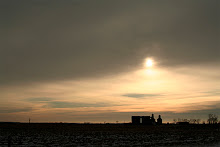Alliance, Nebraska. It's an island of civilization set between the Sand Hills to the east and more fertile plains to the west. The town is only populated by about 8,900 people but compared to the endless hills of sand and grass just out of town it seems like a metropolis.
Our spray crew, consisting of James, Wes, and Tom, has been working on sterilizing the BNSF Sand Hills sub. Sterilization means we are spraying all BNSF property where they want no vegetation to grow. Primary areas of concern are the tracks and ballast, around buildings and bridges, material piles, and parking lots. The process is intense as every square inch of property must be covered and it must be done so when the wind is below 10 mph, not a small feat on the windswept prairie.
The BNSF Sand Hills subdivision stretches east from Alliance through the Sand Hills to Ravenna, NE. After the mining of coal began in the Powder River Basin of Wyoming this former Chicago, Burlington, and Quincy line became an important cor
ridor for coal moving east. Today there is a steady torrent of Powder River coal going east and empty aluminum gondolas going back west.
Our job today was to spray about 20 miles of track near Mullen. The mainline varies between single and double track meaning we would have to dodge the coal traffic. We were lucky today, most traffic was moving east and we were heading west which meant few delays. Tom decided to put me back in the saddle of the passenger side of our hy-rail vehicle.
After getting back up into that seat everything began to come back to me. The switches to control the spray nozzles, the proper positioning of the Radiarc, finessing the boom arm to dodge signs and switchstands without stopping. Strange to be back.
Unfortunately the track inspector that accompanied us had other duties that day and a prohibition on overtime, so we had to quit earlier than anticipated. This was unfortunate since the weather was perfect for spraying and
train traffic was slow. But that's the way it goes.
After getting done, cleaned up, and grabbing food Wes and I were back at the Days Inn taking in the beautiful Nebraska spring weather. Out to the west, however, was a massive, blue front, that dominated the sky. Rain. This was one of those beautiful isolated storms that pop up out of nowhere during the spring and summer. Green hills underneath a mass of swirling white and blue with whispy strands falling off the back of the front and backlit by the orange glow of a setting sun. Adding the spice to this wonderful mural of color are the purple blasts of lightning. Simply amazing.
I grabbed my camera and a truck to get a few shots of this storm and got luckier than I could ever imagine. Just by chance, somehow someway, I photographed a lightning bolt. Just by chance that one bolt would appear in the 1/100th of a second I exposed the frame. I should have bought a lottery ticket.




